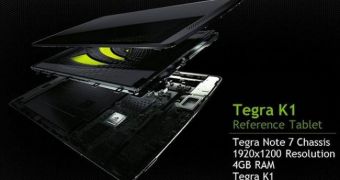During this year’s CES, NVIDIA has pulled the veil off its revolutionary Tegra K1 mobile processor, which is a 192-core super chip bundled with NVIDIA Kepler architecture.
Kepler architecture is behind one of the fastest graphics processing units (GPUS) available on the market, the NVIDIA GeForce GTX 780 Ti.
So that means that all the enhanced features available on next-gen PC gaming devices via the Kepler architecture will now be available on mobile platforms as well.
Now NVIDIA teases a new reference tablet design of the Tegra Note 7 which draws power from a Tegra K1 processor coupled with 4GB of RAM, says AndroidPC.
Moreover, the new prototype boasts a resolution of 1920 x 1200 pixels, an important update, up from the bland 1280 x 800 pixels of the current Tegra Note 7.
To be noted that NVIDIA’s new reference tablet has been mounted in the same case as the current Tegra Note 7, which shows us that the new chips don’t take up more space or generate more space.
If the NVIDIA reference design ever hits the streets (the chip-maker has been talking to some potential partners at CES), it might be one of the first tablets to come with an ARM-based chip and 4GB of memory.
A new NVIDIA tablet boasting a Tegra K1 processor would probably manage to hold its grounds, also thanks to the DirecStylus technology that provides good competition for tablets with Wacom pens (ASUS has launched one at CES too, the VivoTab Note 8).
Qualcomm has also presented its new ultrasound-based stylus technology, so NVIDIA will certainly face some competition in the future. The chip-maker might try to diversify its tablet screen range in the future, as well, by putting out slates with larger screens, which will certainly be appreciated by some users.

 14 DAY TRIAL //
14 DAY TRIAL //